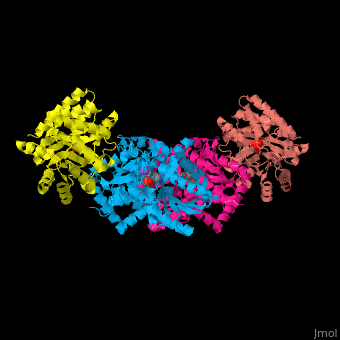Function
Tryptophan synthase (TrpS) is an α2β2 tetramer participating in the biosynthesis of tryptophan (Trp)[1]. TrpS α subunit catalyzes the formation of indole and glyceraldehyde-3-phosphate (G3P) from indole-3-glycerol phosphate (IGP). The β subunit catalyzes in a pyridoxal-phosphate (PLP) dependent reaction the formation of tryptophan (Trp) from indole and serine. The diffusion of indole from the α to the β subunit is facilitated via a hydrophobic channel connecting the subunits. Dimethylallyl tryptophan synthase (DMTS) catalyzes the alkylation of Trp by dimethylallyl phosphate to form 4-(γ,γ-dimethylallyl)-Trp[2].
Relevance
TrpS is not found in animals hence it is tested as a possible drug target for tuberculosis, ocular and genital infections, cryptosporidiosis and as herbicide[3].
Structural highlights
The of TrpS subunit α contains the catalytic residues Glu and Asp[4]. Water molecules are shown as red spheres.
3D structures of tryptophan synthase
Tryptophan synthase 3D structures

